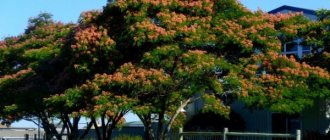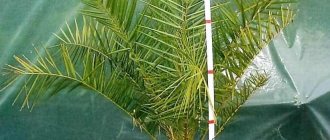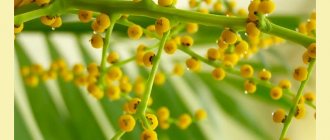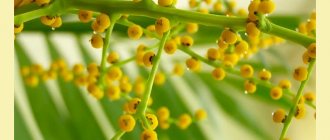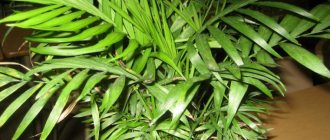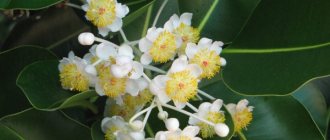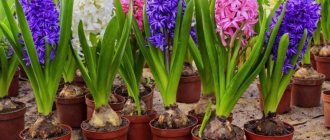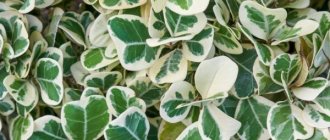Palm trees are strongly associated with the sun, sea, and beach. But not everyone is able to go on vacation when they want. Therefore, flower growers of the south - ficuses, rhododendrons, palms. The areas of modern apartments are such that it is impossible to place large plants in them; winter gardens and greenhouses are a rarity. The optimal solution is chamedorea. This low palm tree with fan leaves is unpretentious and successfully takes root in home conditions, so different from the tropics. It is only important to pay attention to some nuances of caring for the plant and spend time creating the desired microclimate.
What does the plant look like?
Chamaedorea is a fairly numerous genus belonging to the Arecaceae or Palm family (Arecaceae, Palmae, Palmaceae). The name is a combination of two Greek words: chamai (dwarf) and dorea (gift). In old sources the name “neanta” is also found
Hamedorea is highly valued by adherents of Feng Shui, who recommend having such a flower in every office. It is believed that this plant is able to neutralize negative energy, extinguish conflicts, fight melancholy, apathy, absent-mindedness, depression and stress. The owner of the chamedorea becomes more cheerful and cheerful, and looks at life more optimistically.
Most of the currently known 130 species of chamedoreas are low tree-like or bush-like palms with several trunks. But there are also epiphytic plants and even lianas.
Hamedorrhea at home does not look as impressive as in nature, but it is also very worthy
Hamedorea is native to the foothills of humid South and Central American forests. Most often they are found in Mexico, Belize, and Guatemala. Due to the characteristics of its habitat and appearance, Hamedorea has the nicknames “mountain”, “reed”, “bamboo palm”. In the United States it is known as Palma bella, meaning “beautiful.”
Flower growers value the plant for its large leaves (length from 30 cm to 2 m), symmetrically dissected along the central vein into individual “feathers”. The vein may sag in the middle. The shape of the leaves resembles fans. They are located on thin long trunks, similar to the stems of reeds or bamboo. The maximum diameter of the trunk is no more than 3 cm. Characteristic are transverse rings that appear in place of the lower leaves, which gradually fall off. The leaves are either collected in a “bouquet” or resemble a “crown” located at the top of the trunk.
Hamedorea blooms successfully at home, and flowers can appear at any time of the year. Quite inconspicuous velvety small yellow or orangish flowers randomly dot the peduncle. They are very reminiscent of mimosa. Since flowering has no decorative value, it is better to cut off the peduncle even before the buds form, so that the plant does not waste its energy.
Hamedorea flowers are not very attractive; if the goal is not to get seeds, the flower stalks are cut off, not allowing the buds to bloom
Like any palm tree - whether in natural conditions or “in captivity” - Hamedorea cannot boast of a growth rate. In nature, 70–80-year-old plants reach a height of 5 m or a little more; at home, they rarely grow above 1–1.5 m. This is especially true for specimens grown from seeds. At home, chamedorea grows more readily in width than in height. At the same time, its lifespan is practically unlimited. She dies only if the grower does not pay due attention to her and neglects the requirements for living conditions.
Hamedorea is a dioecious plant. This means the presence of specimens with only female (pistillate) and only male (staminate) flowers. Seeds are set on the first ones only under the condition of simultaneous flowering. Artificial pollination is also possible. You can distinguish pistillate plants by the light aroma of their flowers, which is absent in staminate plants. Inflorescences with male flowers are more voluminous and more branched.
Hamedorea is not only beautiful, but also useful. It has been scientifically proven that this plant is one of the leaders in absorbing carbon dioxide and releasing oxygen. Palm tree purifies the air from formaldehyde, trichlorethylene, and benzene. Moreover, harmful impurities are absorbed by both leaves and roots.
When purchasing chamedorea in a store, look for single plants - groups of seedlings closely planted in one pot are usually short-lived
Description of the plant
Chamaedorea Breedbladig is a modern hybrid of the well-known Chamaedorea elegans. Bridble differs from the latter chamedorea in larger and more fragrant flowers and a rich, emerald hue of foliage. In addition, bridble is slightly lower and reaches a height of only 1.5 m (however, provided there is fertile soil and a comfortable, large tub, it can grow higher - up to 2 m).
The remaining morphological parameters of bridble and elegans are identical:
- creeping green stem (over time acquiring a chestnut hue) with numerous thin shoots (fronds);
- 6–7 leaves on each shoot;
- long-petiolate, arcuate, pinnately shaped leaves;
- the leaf blade consists of 12–15 linear-lanceolate lobes 20 cm long;
- spherical bright yellow, slightly velvety flowers, similar to mimosa, collected in paniculate inflorescences;
- black, spherical fruits similar to berries, each containing one seed.
Did you know? In the countries of Central and South America, not only berries are eaten, but also leaves and unopened buds of chamedorea inflorescences. They are considered an excellent vitamin supplement for salads.
Hamedorea graceful, Seifritz and others - types and their differences
Among the variety of chamedorea species, the following feel most comfortable at home:
- Hamedorea Arenberg (arenbergiana) or broadleaf (latifollia). The trunk is always single, with 5–10 leaves located on it at the same time. The maximum height of the plant is 1.6–1.8 m. The leaf cuttings are quite rigid, so they are straight, but individual “feathers” hang down. Leaf length is 30–35 cm, width is 8–10 cm. The flower tolerates even completely artificial lighting.
- Hamedorrhea high (elatior). New daughter plants are formed from one rhizome every year. Each of them has 4–6 leaves. The length of the leaf in nature is about 1.5 m, at home - about 1 m. The central vein is poorly expressed, so the leaves often bend and, as a result, dry out. Compared to other chamedoreas, the plant is tall - 4–5 m.
- Hamedorea geonomoformis (geonomiformis). Tree-like palm 1 m high or slightly higher. The leaves are gathered into a “crown” at the top. There are 6–8 of them in total. The length of each is about 25 cm, width - 12–15 cm. The deep dark green shade of the leaf blade is characteristic of the species.
- Hamedorea graceful (elegans), aka beautiful (bella), aka hitmilis. Many shoots resembling bamboo stems grow from a vine-like trunk, almost completely hidden underground. The height of the plant is 1.5–2 m. There are quite a lot of leaves – 24–28 at a time. In the middle, the central vein sags, so from the side they look like sickles. The flowers are pastel yellow, large for a chamedorea, with a pronounced aroma.
- Hamedorea stolonifera (stolonifera). It seems that many plants are closely planted in one pot, but these are separate thin shoots formed from one rhizome. At home, the palm tree grows up to 0.75–1 m. The leaf length is 20 cm, the width is half that. The flowers, unlike most chamedoreas, are bright orange.
- Hamedorea Ernest-Augusti (ernesti-augusti). A tree-like low (slightly more than a meter) plant with a thin trunk. A distinctive feature is the presence of aerial roots at the base of almost all internodes. The maximum number of leaves is 8–10. Leaf length is 55–60 cm, width is 20–25 cm. The leaf blade is solid, but deeply dissected (shape like a heart). Unlike other palm trees, it grows quite quickly and often blooms even at home. The flowers are orange-red or bright scarlet.
- Hamedorea unicolor (concolor). Plant height is 1.2–1.3 m. The leaves are small, light green in color. In a sufficiently spacious pot, over time, a whole “grove” will form, a continuous carpet of leaves. Only plants aged 70 years and older bloom.
- Chamedorea metallica (metallica). Similar to the previous view. It differs from the others in the shade of a very dense leaf plate - a rich dark green color, which from a distance appears almost black, but in the sun it shines glossy, like polished silver. The trunk of adult plants becomes woody. The species tolerates shade well. It is extremely rare for sale.
- Hamedorea bridbl. A selective hybrid, bred on the basis of Hamedorea graceica. He inherited the appearance of the “parent”, differing favorably from him in the size of the inflorescences, the brightness of the flowers and their aroma.
- Hamedorea Seifritz (seifrizii). Bushy plant. Leaves on long petioles. Individual “feathers” are spread out, the leaf resembles a fan. This palm tree is demanding of sunlight.
- Chamedorea cascade (cataractarum), also known as “cat palm”. The plant consists of many miniature palm trees. The leaves are light green, rather thin. The species is very sensitive to watering - it tolerates moisture deficiency worse than other chamedoreas, but when there is enough water, it quickly forms new daughter shoots and noticeably increases in growth.
- Hamedorrhea erumpens. The height of the plant is no more than 1 m. The leaves are soft and drooping. New shoots form at the roots at any time of the year.
Popular types of Hamedorea
In addition to the salon or cabinet palm, as Hamedorea gracilis and bridble are also called, the following varieties are popular:
- Single color. Low (1–1.5 m), but bushy plant with narrow, thin leaves of a light green color. Unpretentious. Once planted in a wide flowerpot, it soon grows into a whole grove. It blooms with pale yellow flowers, but very rarely (about once every 70 years).
- Seifritz. A large, spreading plant that can reach 3 meters in height. For this reason, it is suitable for growing in spacious rooms with high ceilings. Demanding on moisture.
- Stoloniferous . It is distinguished by a large number of shoots, wide (10 cm) dark green leaves and orange flowers. Forms adventitious roots on stems.
- Metallica. This beautiful plant gets its name from its lush, dense emerald leaves with a silvery sheen. Reaches no more than 2 m in height.
- Ernesta-Augusta. This palm tree is difficult to confuse with others due to the red hue of the flowers and large (50–60 cm long and 25 cm wide) leaves, shaped like a heart.
Microclimate for growing plants at home
The conditions to which Hamedorea is accustomed in its historical homeland differ sharply from the microclimate of modern apartments. Therefore, the “requirements” of the flower must be treated with understanding and, if possible, satisfied:
| Factor | Recommendations |
| Location | The plant is suitable for both a window sill and a place in the back of the room. An ideal area is 1–1.5 m from a window facing south or east. Rotate the chamedorea every 1.5–2 weeks so that the leaves develop evenly and the plant becomes symmetrical. In summer, the pot can be taken out into the garden, onto the terrace, or balcony. The only condition is the presence of protection from direct sunlight, wind and rain. |
| Lighting | Penumbra or bright but diffused light. If exposed to direct sunlight from 10:00 to 17:00, shade the plant. |
| Air humidity | The higher the better. The minimum indicator is 50%. Spray the flower 2–3 times daily, ventilate the room, wipe the leaves with a damp sponge every 10–12 days, or give the flower a shower. Place several vessels with water, containers with wet moss, expanded clay, or a special humidifier device nearby. |
| Temperature | In summer, the optimal temperature is 22–27ºС (or slightly higher). More than 30ºС is no longer desirable. In winter - about 15ºС (this applies to both air and soil). When the thermometer is below 12ºC, chamedorea dies. |
Hamedorea can be placed not only on the windowsill, but also anywhere else in the room
Indoor varieties of mini palm trees
The genus Hamedorea includes more than 100 species. Several of them have been successfully adapted for growing at home. A brief description and photo will help you understand the diversity of palm trees:
- Hamedorea graceful. Also known under the names beautiful, elegans. Forms a spreading bush of thin branches with feathery leaves of a pleasant green hue. Up to 7 such stems grow from each root. The bush turns out to be spreading due to the arching of the leaves. Blooms often. The inflorescences consist of small orange-red flowers.
- Hamedorea unicolor. It is considered the most unpretentious. It is similar to Hamedorea elegans, but forms a central strong trunk up to 1 m high. It consists of internodes of dead leaves. Side stems add fullness to the bush. The flowers are yellow.
- Hamedorea Ernest-Augustus. Forms a single, relatively thick reed trunk from dead parts of the plant. Aerial roots appear at the stem nodes, so this variety of chamedorea is easily propagated by cuttings. The top of the palm tree is decorated with large, solid oval leaves with a forked end. The color is rich. Forms flowers in the form of balls.
- Chamedorea tall. Consists of a collection of thin reed stems. At the top of each grows 4-6 dissected, feathery leaves of a rich green hue. The flowers of the palm tree are bright orange, paniculate, and fragrant.
- Hamedorea bridble. More similar than others to its wild counterparts. Only it has miniature sizes, up to 1.5 m. The inflorescences of this palm tree are also brighter and more fragrant.
Planting and transplanting procedure
Young chamedoreas under the age of 5 years are replanted annually. Mature palm trees - only when the need arises (roots are visible from the drainage hole). As a rule, this happens once every 3–4 years. The best time for the procedure is from early to mid-spring. If the flower has reached such a size that it is physically impossible to replant it, limit yourself to replacing the top layer of soil in the pot (4–5 cm).
The new container should be approximately 7–10 cm wider than the previous one. Choose tall and narrow ceramic pots or wooden planters. The root system of chamedorea should go deep into the ground. The presence of a large drainage hole is an additional plus.
Hamedorea, like any palm tree, feels best in a classic tub or in a bucket-like pot
There is a special soil mixture for palm trees, but you can make your own substrate:
- fertile turf, universal soil for indoor plants, leaf humus, coarse river sand (3:2:2:1);
- fertile turf, humus, peat chips, perlite or vermiculite (equal parts);
- soil for palm trees and any “leaving agent” - finely chopped sphagnum moss or coconut fiber, sawdust from coniferous trees, brick chips, crushed tree bark, pieces of pumice (5:2).
Hamedorea is replanted only by transshipment. Any palm tree reacts very negatively to exposed roots.
- Fill the bottom of the new pot with drainage. The layer thickness is at least 5 cm. Then add twice as much sterilized soil.
- Moisten the substrate well and remove the plant from the pot, trying to destroy the earthen ball as little as possible.
- Using a sharp, clean knife, cut off the thin roots from below, which have rolled into a solid lump that looks like felt.
- Place the chamedorea in a new pot and add soil around the edges. Compact the soil well. You cannot bury the plant deeper than in the old container.
- Water the flower a little with warm water. For 10–12 days, protect the palm tree especially carefully from direct sunlight.
Hamedorea is replanted only when the roots have completely mastered the space provided to them.
Video: Replanting Hamedorrhea
Spectacular and incomparable chamedorea
Chamaedorea - the genus unites low-growing woody, flowering plants, the number of which numbers one hundred and thirty-three varieties and occupies the main place in the Palm family.
The homeland of Hamedorea is the mountainous territories of both the South and Central America, as well as the Mexican mountain ranges. Natural comfortable conditions allow the Hamedorea palm tree to reach a height of two meters. The root system of this gorgeous flower forms a huge number of three-centimeter bamboo-shaped stems on which green original feathery leaves rise. Young leaves resemble feathers.
The local population feeds on the unopened male inflorescences of Hamedorea, which are called "pakaia". In tropical forests, the mountain palm chamedorea chooses places near a tall tree in order to hide in the summer from the direct rays of the sun that burn its leaves.
The names translated from Greek are “chamai” - dwarf and “dorea” - gift.
In indoor conditions, flower lovers grow chamedorea as a foliage and decorative miracle, thanks to its graceful feathery leaves.
When buying a palm tree for your home, the question arises: how quickly does Hamedorea grow? This indoor palm grows slowly. Upon reaching adulthood, it acquires a height of one hundred and twenty centimeters. The most important thing is that at any age, the chamedorea bamboo palm looks charming. Tiny palms have proven themselves well in compositions placed in glass containers. Larger specimens can be an excellent decoration for gardens, greenhouses, and offices.
It’s also interesting: how does chamedorea bloom? Flowers do not have any special decorative value. The green branch of the peduncle is completely covered with delicate flowers that resemble mimosa flowers. The clear contrast with the dark leaves of the palm tree gives the plant more originality. By the way, the flowering of indoor chamedorea can be seen by watching the video.
Hamedorea photo can be viewed in the next section of the article.
Important nuances of caring for a reed palm
The dormant period of chamedorea is poorly expressed, so winter and summer plant care differ little.
Watering
Watering is the main component of chamedorea care. It will survive overdried soil for some time, but will react sharply negatively to a waterlogged substrate. The plant prefers to obtain the necessary moisture from the air rather than from the soil.
In summer, chamedorea is watered abundantly every 3-4 days. A layer of substrate to a depth of 3–4 cm should dry completely. A clear sign indicating excessive watering is the unpleasant smell of dampness and rot coming from the soil. In winter, the intervals between waterings are increased to 4–6 days.
For watering and spraying, use soft water heated to a temperature slightly above room temperature (about 30ºC). If it is not possible to water the flowers with rain or melt water, leave the tap water for at least a day. To neutralize calcium compounds, add a few citric acid crystals to the container.
Fertilizer application
Hamedorea, compared to other palm trees, requires more fertilizer. But if the flower is transplanted at the wrong time, especially in autumn or winter, fertilizing begins only next spring. The same applies to store-bought and transplanted plants, as well as chamedoreas obtained vegetatively. They are fertilized for the first time no earlier than 3–4 months after transplantation.
Hamedorea is fed only during the active growing season - from mid-spring to late summer. One feeding every 15–20 days is enough. If you are satisfied with the condition of the palm tree and the growth rate, apply fertilizer once a month. In winter, fertilizing is excluded.
Whenever possible, choose fertilizers that come in the form of long-dissolving granules that are applied dry to the soil. If there is no alternative, liquid complex mineral fertilizer is also suitable. In addition to root feeding, you can spray the leaves with fertilizer, reducing the concentration of the product by three times. Just don’t use organics - it’s unknown how an exotic plant will react to such unusual means.
Reproduction methods
It is not easy to propagate the beautiful chamedorea; this process requires skill and patience. Novice gardeners prefer to purchase young plants in stores and garden centers.
Find out how to properly plant indoor flowers in a pot.
More experienced people can try growing a palm tree in one of the following ways:
- Seeds . The complexity of this method lies in the limited shelf life of the seed. To achieve good germination, they need to be planted immediately after harvesting or at least in the next couple of months. Before planting, the seeds need to be soaked for 2–5 days in warm rain or melt water. You should also file each seed with a grindstone on one side to speed up germination. The seeds are placed in disposable cups filled with a mixture of equal parts of sphagnum, steamed sawdust and quartz sand, with the sawed side down. There is no need to sprinkle them, just slightly deepen them into the substrate. The top of the container is covered with film. The seedlings are moved into the soil when the first leaves reach 2–4 cm.
- Dividing the bush . This method is not very suitable for Hamedorea bridble due to the fragility of its roots. If you still want to replant the bush, it is better to combine this process with replanting.
- Children . Every year, shoots form at the roots of chamedorea. They can be transplanted into a separate pot after 4–7 leaves and roots appear. 3-4 shoots are usually planted in one container.
Table: Disease treatment and insect control
| Problem | External manifestations | What to do? |
| Shchitovka | At first almost flat, then swelling elliptical growths of all shades of brown; reddening or yellowing areas of tissue around them; black soil in a pot. | Prevention:
Struggle:
|
| Spider mite | Small dark dots are punctures on the leaves and discolored areas of tissue around them; dried, curled leaves, braided with thin, almost transparent threads. | Prevention:
Struggle:
|
| Mealybug | Leaves covered with a white coating similar to shreds of cotton wool and sticky transparent secretions, especially on the underside; soil coming off the edges of the pot; a ring of whitish, waxy coating in this place. | Prevention:
Struggle:
|
| Thrips | A scattering of small brown dots on the leaves, clearly visible in the light; in especially severe cases - silver stripes or mesh on the leaf plate. | Prevention:
Struggle:
|
| Fusarium | Losing tone, drooping leaves, yellow blurry spots on the leaf plate; completely yellowed lower leaves; thinned stems. If the disease is not dealt with, the spots turn brown and a characteristic smell of rot appears. | Prevention:
Struggle:
|
| Late blight | Rapidly spreading lilac-brown spots on leaves and stems, gradually turning black and softening tissue in these places. The appearance of a putrid odor. | Prevention:
There are no effective measures to combat the disease. If it is detected early, replanting while pruning all parts of the plant that appear to be infested can help. Then, for 3–4 months, the flower is watered every 2–3 days with a 1% solution of any fungicide, Alirin-B, Previkurt. |
Photo gallery: Diseases and pests
The scale insect has a dense shell, so not all insecticides are effective against the pest.
To combat spider mites, special preparations are used - acaricides.
If you don’t fight the mealybug, the plant will soon be covered with a continuous layer of whitish plaque.
Thrips are flying insects, so they are easy to spot: just shake the flower
A plant suffering from fusarium wilts and dies in a matter of days.
Late blight is very similar to rot
Characteristics and features of an indoor palm tree
Hamedorea is a low-growing tree of the Palm or Arecaceae family. Its natural habitat and place of wide distribution are the equatorial regions of North America and the northern regions of South America. The culture grows in humid foothill tropical thickets, under the shade of larger trees. Hamedorea forms a tree or shrub with many similar shoots or vines. The height of the largest varieties reaches 5 m, but most palm trees do not reach 3 m. At home, chamedorea grows up to 1.5 m and has a trunk thickness of up to 3 cm.
The beauty of the plant lies in the graceful fans of leaves. Their color is light green. The shape is feathery. Hamedorea blooms at a young age. Small inflorescences do not represent much decorative value, but are generally neat and attractive (see photo).
Other features of the exotic:
- The plant develops slowly. A specimen planted from a seed spends up to six months just for germination. In other cases, growth will be slightly faster.
- In nature, chamedorea is tiny, but at home it will still take up a lot of space. Give the palm space.
- Greens effectively cleanse the air in the house from harmful particles: benzene, formaldehyde, etc.
Features of reproduction
Hamedorea is unique among palm trees in that it reproduces not only by seeds, but also vegetatively (by daughter shoots). Amateur flower growers, as a rule, do not experience a shortage of planting material.
Germination of seeds
Hamedorea seeds are easy to purchase, but be sure to pay attention to the expiration date
Hamedorea seeds ripen for about 6 months, then quickly lose their viability. Getting them at home is quite problematic, so when purchasing, always pay attention to the expiration date. Every month the number of specimens capable of germinating decreases by approximately 10%. Therefore, already 10 months after collection, the purchase is impractical. Hamedoreas obtained from seeds grow more slowly than usual, but the plants do not inherit diseases from the “parent”.
- 7–8 days before planting in the ground, soak the seeds in water or Zircon solution, maintaining the temperature of the liquid at 30–35ºС.
- Carefully remove the outer fleshy membrane. Using a thin file, needle file, or nail file, make a cut in the hard shell, do not remove it.
- Fill plastic cups with a mixture of peat or finely chopped sphagnum moss and steamed sawdust with coarse river sand (all ingredients should be taken equally). Moisten the soil with a spray bottle.
- Place the seeds on the surface of the substrate (add 2-3 pieces to each cup), press down 1-1.5 cm. Do not pour on top. Cover with plastic wrap.
- Provide a constant temperature of 29–32ºС, humidity within 90–100%, protection from direct sunlight, and, if possible, bottom heating. Remove the plastic for 2-3 minutes every day. Under suitable conditions, seedlings will appear in just over a month, but the procedure can take 3–6 or even 9 months.
- When the first true leaf reaches a length of 4–5 cm, transplant the chamedoreas into separate pots. Substrate - fertile turf, river sand, leaf soil, humus (2: 2: 1: 1). Every day, gradually increasing the period of time, place the seedlings at their future “place of registration” so that they get used to the new conditions. Maintain a temperature of at least 25ºC and high humidity. Spray young plants 2-3 times a day.
- After 4-5 months, transplant the chamedoreas into soil for adult plants and care for them as usual.
Botanical description
Hamedorea is an ornamental foliage plant. It is because of the beautiful feathery leaves that this palm tree is grown at home. Hamedorea flowers are devoid of brightness and decorativeness and are interesting only because they can bloom at any time of the year. They are small, slightly velvety, bright yellow in color, appear on the peduncle in random order along its entire length. Many gardeners generally recommend removing flowers at the budding stage, so as not to weaken the plant by flowering.
Dracaena at home - everything you need to know about care
What else should you consider if you decide to grow chamedorea at home? Get ready for the fact that this palm tree grows slowly, like other palm trees, especially for those specimens that are grown from seeds: it takes an incredibly long time for a sprout to hatch from a seed - it can “sit” motionless in the ground for more than six months.
- Maranta - care, photos, types
In the photo: Growing Hamedorea in a pot
Well, the main thing you need to know before planting or buying chamedorea: it loves very humid air. And now about the issues of care in more detail.
Why does chamedorea dry out and leaves turn yellow?
Washingtonia palm - home care
Hamedorea leaves may dry out due to improper care. With insufficient watering or dry indoor air, the tips of the foliage may turn yellow and fall off. To prevent this from happening, it is important to monitor the humidity in the room. If your home does not have a humidifier, you can get by by spraying it daily with water at room temperature from a spray bottle. A container of water located near the flower can be helpful in solving the issue of hydration. In spring and autumn, when the heating season has not yet opened, the indoor air condition in the vast majority of apartments is normal. But you definitely need to keep an eye on it when the heating radiators are turned on, drying out the air.
Transfer
As the palm tree grows, it should be transplanted into a larger pot. The frequency of the procedure is once every 2-3 years. Adult plants are replanted once every 5 years. The procedure is carried out as follows:
- Prepare a larger pot.
- Pour expanded clay and some soil into it.
- Place the palm tree in the center, sprinkle the root system with gentle movements, and compact the soil.
- After transplanting, water the plant.
Next, Hamedorea should be given a few days of rest.
How to transplant
After purchasing a Hamedorea “Bridble” seedling, there is no need to rush to move it to a permanent place. The plant is easily injured and has difficulty withstanding this procedure. In a new place, you should wait at least 14 days for acclimatization. Transplantation into a permanent pot is carried out using the transshipment method in a certain order. Transplantation is carried out using the transshipment method:
- pre-moisten the soil in the pot, place it on its side and remove the flower, keeping the earthen lump;
- if necessary, carefully clean the root system from the soil substrate and inspect it for the appearance of rot, remove damaged roots and treat the sections with a pink solution of potassium permanganate, and then with crushed pharmaceutical activated carbon;
- in a new pot, a couple of centimeters wider than the previous one, with holes in the bottom to drain excess water, a layer of drainage made of expanded clay or broken brick is placed;
- pour a layer of fresh soil, place the plant on it with or without an old ball of earth (in this case, carefully straighten the roots);
- empty spaces in the pot are covered with fresh soil, lightly pressing it down;
- the plant is watered and not disturbed for a week, giving it the opportunity to recover after the procedure.
Transplant time is in spring, April or May. After it, Hamedorea bridble is not fertilized for quite a long time - several months.
Moisturizing the substrate. It is necessary for easier separation of the earthen coma. Place the leaves in a plastic wrap, protecting them from the negative influence of the external environment. Fix in the desired position so as not to break during transplantation. Carefully remove the plant from the pot along with the root system and part of the soil.
It is important not to damage the delicate roots, otherwise the palm tree will not take root.
Pour a thick layer of drainage based on expanded clay, crushed natural stone, and brick into a new container. Place the palm tree on an embankment, cover the roots with the prepared soil substrate, fill the tub with it so that the root collar does not remain bare.
Remove the fixing polyethylene. Spread the leaves and water the soil.
By following these detailed instructions, you can ensure that your chamedorea moves to a new location as easily and comfortably as possible. In the future , as the roots grow and develop, young palm trees need to be replanted using the same method every 12 months.
Diseases and pests of Hamedorea
Like any living plant, a palm tree tends to attract harmful insects. The appearance will indicate the presence of a problem. Knowing the cause, you can easily correct the situation and return the plant to a healthy appearance.
- The leaves dry out, turn yellow, and fall off - this indicates the presence of dryness in the air. If there is a lack of humidity, pests such as spider mites and scale insects can appear. This can be corrected by airing and spraying.
- If the entire stem dries out, this is a sign of a disease, pest attack, or a reminder of the age of the plant. In this case, pruning and replanting into another pot is required.
- Black spots on the leaves, yellowness at the tips - tell the grower to pay attention to the condition of the soil. This manifestation is possible with root rot, when there is an excess or lack of moisture.
- Lethargy and darkening of the leaves means that the plant does not have enough heat.
- The bottom part dries out - this is normal. It is necessary to remove old dry leaves starting from bottom to top.
When chamedorrhea is weakened, it is more often susceptible to fungal diseases. Late blight and fusarium occur. This can be caused by poor soil or waterlogged soil. The plant is treated with fungicidal preparations.
When pests appear, such as aphids, scale insects, mealybugs, it is necessary to treat the trunk and leaves of the chamedorea with a soap solution. Then wipe thoroughly and spray with insecticidal preparations. Folk remedies include potassium soap or spraying with tobacco infusion.
Signs and superstitions
There are a lot of signs and superstitions associated with growing mountain palms:
- It is accepted that chamedorea growing in the house gives its owners peace of mind and confidence, and increases self-esteem.
- Selfish natures will have to refuse to purchase a flower. Otherwise, they will become completely unresponsive to others.
- The flower provides certain benefits to people of various professions. For example, it will help athletes win and reach new heights, people in creative professions will receive recognition, and businessmen will bring their projects to life.
- Possessing powerful energy, the mountain palm has a positive effect on a person’s destiny, helps to achieve success in any direction, and prevent family quarrels.
- A pot with a plant scares away energy vampires and cleanses the aura.
Hamedorrhea can also have a negative effect. According to popular belief, if you place a pot in the house, disaster will happen. To prevent such consequences, the flower must cross the threshold of the house not in the hands of a person , but on wheels. This could be, for example, a stroller or cart.
The plant has a beneficial effect on the atmosphere in the house only when its inhabitants have pure intentions. Otherwise, it is better not to purchase the flower, because... he may die.
So, chamedorea needs specific care at home. Compliance with the instructions for the maintenance of this exotic plant is the basis for its healthy growth. The main thing is to provide it with a sufficient amount of light, optimal humidity and timely feeding, and take care of the availability of the necessary space in the room.
Care
Caring for the plant consists of following the watering regime, periodic feeding, as well as observing all the conditions to which it is accustomed in its natural environment.
Lighting
The mountain palm grows in the lower tier of the tropics, therefore, does not need a lot of light. It is enough to place the flower pot in the shade or partial shade and it will feel good.
Hamedorea feels great under artificial light in a greenhouse or in a shaded part of an apartment.
Temperature
This exotic shrub has certain temperature requirements:
- In hot weather, keep the temperature to at least 27 degrees.
- If you sharply reduce the temperature in the room where the flower is located to +10 degrees, it will die. Even at +12, the flower begins to lose leaves and becomes lethargic.
- Temperature fluctuations are fraught with danger for the plant, and if the difference in indicators reaches 7 degrees, it will die.
- The top layer of soil should warm up well, so the pot should not be placed on cold surfaces or drafts. The soil temperature should be identical to the air temperature.
- In winter, a temperature of 16-22 degrees is enough for a mountain palm tree.
Humidity and watering
The humidity level for chamedorea should not fall below 55%, otherwise the flower will stop developing, lose its splendor and die
Watering is also important. The soil should always be moist, and watering should be done when the soil is half dry
Excess moisture has a bad effect on the life of the mountain palm. The watering regime should be adjusted from the first days of the flower’s stay in the house.
For foliage spraying and watering, soft, warm water at room temperature is required.
Top dressing
Feeding for chamedorea must be selected very carefully. Folk remedies will not work in this case and may harm the exotic palm tree.
Fertilizers are applied to the soil from April to August with a frequency of 1-2 times a month. It is at this time that intensive growth of the bush is observed. To maintain nutrients in the soil, specialized mineral fertilizers in granules, as well as solutions, are used.
Transfer
The procedure is carried out with extreme caution so as not to harm the exotic beauty. The instructions are as follows:
- We sterilize the previously prepared soil, and when the purchased flower gets used to the new conditions (after 10-14 days), we replant it.
- If the tree is young, it must be replanted annually. Adult bushes are replanted after 3-4 years.
- We cover the bottom of the pot with drainage, and then pour in the substrate.
- We thoroughly water the plant 30 minutes before the start of the procedure so that it can be easily removed along with the earthen lump without damaging the roots.
- We handle the chamedorea, untangle the roots and place them in fresh soil, sprinkle the empty areas with earth and water them thoroughly.
If replanting is not necessary and the tree has enough space in the old pot, simply renew the top layer of soil.
Priming
The easiest way is to purchase ready-made soil in a specialized store. Self-preparation is also acceptable and includes a number of basic components:
- turf land – 50%,
- leaf soil – 20%,
- peat – 20%,
- quartz sand (sifted) – 10%.
The soil must not only be of good quality, but also sterile. Disinfection can be done by calcination or freezing to prevent the presence of pests and possible diseases.
Pot
The main requirement for a pot is its stability, because... As the palm tree grows, it will gain significant weight. The volume of the container depends on the height of the tree:
- for young palm trees no higher than 50 cm in height - 12-15 cm;
- above this indicator – 16-25 cm.
Before planting, you should make several holes at the bottom for roots to grow, and then lay a drainage layer. The plant should not be planted immediately in a large pot - the capacity should be increased as it grows.
Trimming
Pruning helps get rid of diseased parts of the plant, give the tree a fresh look, and prevent the spread of various infections. Dried, damaged and diseased leaves must be pruned.
The procedure should be carried out as needed, using previously disinfected scissors. At the end of the process, the cutting sites of chamedorea need to be treated with fungicides, and the pruning itself should be carried out as close to the base as possible.
Rest period
Hamedorea is a tropical plant, so it needs a period of rest. “Wintering” of the mountain palm occurs in mid-autumn - end of winter. The owner’s main task is to ensure a comfortable temperature regime - this is 10-15 degrees above 0. The temperature is reduced gradually, while simultaneously reducing watering in mid-autumn.
How to care for chamedorea
Given its unpretentiousness, caring for chamedorea at home will not cause much trouble. The main rule that owners of mountain palm trees should remember: the “head” likes excess moisture, the “legs” (roots) do not.
Lighting
The bamboo palm does not require intense lighting even during active growth. Shade tolerance greatly facilitates the care of chamedorrhea. She feels comfortable on northern window sills. If the windows face south, it is better to place the plant in the back of the room. With a western or eastern orientation, partial shading will be required, otherwise the leaves of the chamedorea will fade due to excess light.
Temperature
Hamedorea is able to grow in a wide range of temperatures. Optimal values are from 18 to 26 degrees. If the thermometer rises higher, the plant will easily tolerate it. The lower limit of endurance is 12 degrees. The plant can withstand lower temperatures only for a short period of time, then it dies.
Hamedorea is loyal to sudden changes and even drafts. Moreover, regular ventilation and temperature fluctuations within acceptable limits activate its growth.
We recommend reading
Home care for Sansevieria
Home care for Chlorophytum flower
Home care for Gloxinia
Home care for Hibiscus flowers
Air humidity
Like any inhabitant of the tropics that finds itself on home windowsills, chamedorea is demanding of air humidity. The optimal level is 55 percent. To achieve this, daily spraying with soft, settled water is sufficient. In winter, the mountain palm is removed away from the radiators, protecting it from streams of hot, dry air that can damage the leaves.
At low air temperatures, it is better not to spray chamedorea, so as not to provoke the development of fungal diseases. You can place it on a pallet with important expanded clay. Dust that collects on the leaves is removed regularly. Moreover, it is not advisable to wipe them to avoid damage. It is better to rinse the bush under a warm shower.
Trimming
During the growth process, the lower leaves die off, so caring for chamedorea at home involves removing them. They are cut with scissors without waiting for complete yellowing. Under no circumstances should it be torn from the stem. Most gardeners recommend trimming the flower stalks of chamedorea: they have no decorative value, but they take a lot of energy from the plant.
Watering
The earthen ball is kept in a moderately moist state, allowing the top layer to dry between waterings. The amount of moisture a plant needs can vary depending on age, time of year and air temperature. To avoid flooding the chamedorea, “feel” the soil - if it is wet, wait a few more days.
For irrigation, use rainwater, spring water, or tap water, which has been left in an open container for several days. Be sure to warm it up to room temperature! Do not boil it or clean it using household filters.
Fertilizer application
Like any indoor flower, chamedorea needs additional minerals. Any organic or mineral fertilizer for decorative foliage will suit it. The usual ratio of nitrogen, phosphorus and potassium in them is 10:5:7, but it may vary depending on the manufacturer. You can purchase specialized fertilizer for palm trees.
During the period of active growth, chamedorea is fertilized twice a month; in winter, once will be enough. The bamboo palm gratefully accepts not only root, but also leaf feeding. In this case, the concentration of the drug should be lower, according to the instructions on the package. Do not process chamedorrhea “sheet by leaf” at air temperatures below 18 degrees.
Care after purchase
Experienced gardeners recommend replanting chamedorea immediately after purchase for several reasons:
- “Dutch” plants are forced into too small pots.
- They are planted in a sterile, low-nutrient substrate, which is not suitable for growing on home windowsills.
- There may be pests in the roots, which are important to recognize promptly.
Despite the fact that chamedorea has an extremely negative attitude towards penetration into the roots, part of the soil is peeled off when replanting to ensure that there is no rot. If there are any, the damaged areas are cut off, treating the cut areas with crushed charcoal. If the root system is in order, the plant is placed in a new, more spacious pot, soil is added and placed in a greenhouse until young leaves appear.
Care during the flowering period
The chamedorea flower has a pleasant aroma, but has no decorative value. Therefore, most gardeners trim the flower stalks so as not to weaken the plant. If you still want to see flowering or get seeds, provide your green pet with additional feeding. Moreover, during this period, fertilizer is used for flowering plants.
Reproduction
There are several options for propagating Hamedorea:
- Seeds. The most labor-intensive and time-consuming method for obtaining a new plant. Seeds germinate only in greenhouse conditions, where the air temperature remains between 25–27°C and a high level of humidity is constantly maintained. Shoots appear only after 3–5 months, at which point the petals have already grown to 4 cm and the plants are transplanted into larger containers.
- Escape. They are separated from the plant during active growth; the palm tree tolerates this more easily in early spring. The shoots are placed in a glass of water or a damp substrate. They are placed in a dark place and periodically moistened.
- Dividing the bush. Dividing the plant into two parts is allowed only if it has already grown to its full height. No special care or conditions are created for this.
